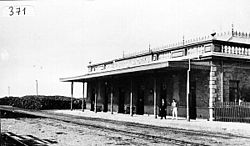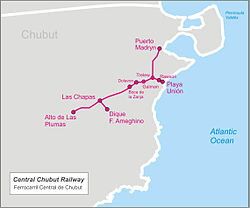Central Chubut Railway
| Central Chubut Railway | |||
|---|---|---|---|
 Puerto Madryn terminus, c. 1930. | |||
| Overview | |||
| Native name | Ferrocarril Central del Chubut | ||
| Type | Inter-city | ||
| Status | Defunct | ||
| Locale | Chubut | ||
| Termini | Puerto Madryn Las Plumas | ||
| Ridership | 197,936 (1948) | ||
| Operation | |||
| Opened | 1888 | ||
| Closed | 1958 (1958) | ||
| Owner | Government of Argentina | ||
| Operator(s) | Ferrocarriles Argentinos | ||
| Technical | |||
| Track gauge | 750 mm (2 ft 5 1⁄2 in) | ||
| Old gauge | 1,000 mm (3 ft 3 3⁄8 in) | ||
| |||
The Central Chubut Railway (in Spanish: Ferrocarril Central del Chubut) was a British-owned company that built and operated a 1,000 mm (3 ft 3 3⁄8 in) metre gauge railway line in the Argentine province of Chubut in the Patagonia region at the end of the 19th. century.
Contents
1 History
1.1 Beginning
1.2 Nationalisation
1.3 Decline and closure
2 Gallery
2.1 Relics
3 See also
4 References
5 External links
History
Beginning

Locomotive in Puerto Madryn, 1888.

Locomotive and workers in Torre José, c. 1900.

Railway bridge in Rawson, 1920s.

Locomotive at Rawson, 1923.

Gaiman station, c. 1920.

Boca de la Zanja station, c. 1930.
In 1884 the Argentine government granted the Welsh immigrant Lewis Jones a concession to build and operate a railway between the valley of the Chubut River and Porth Madryn on the southern side of the Península Valdés. With the help of Asahel P. Bell, an engineer, Jones set up a company in Liverpool, England to finance the construction.
On October 1884 Law N° 1539 that allowed company to build the line, was promulgated. Works began in 1886, directed by engineer Jones Williams, in both cities simultaneously, Puerto Madryn and Trelew. Apart of the local workers, several groups of immigrant were brought from Italy, Spain, Syria, Wales among other countries on the Vesta ship.[1][page needed]
On 11 November 1888, a line 70 km long between Trelew and the quay in Puerto Madryn was opened. It included the first telephone line of the region. Journey time (that were made on horseback) reduced from 20 hours to only 2 hours in train.[2][page needed] From Trelew the line was extended 50 km to Gaiman on 31 December 1908 and from there to Dolavon on 12 October 1915. In 1910 a 450-mt. length dock was opened in Puerto Madryn. The railway station would be opened three years after.[3]
Nationalisation
In 1920 the company was nationalised, being added to Ferrocarriles Patagónicos of Argentine State Railway network. Soon after, the railway extended its tracks to Las Plumas. CCR's track gauge was converted to 750 mm (2 ft 5 1⁄2 in) in 1922,[4] and later the line was extended from Dolavon to Las Plumas.
In 1923 the branch to Rawson and Playa Unión was built. In 1945 another branch from Las Chapas to Florentino Ameghino levee was opened. That branch was used to carry cement from Comodoro Rivadavia, moving around 1,500 ton per month. A project to extend the railway from Las Plumas to Paso de Indios was never carried out. The Government alleged technical issues for that decision.
The dismissed project included to extend the CCR line to Trevelin and Esquel (to make a connection with La Trochita to Ingeniero Jacobacci) and then with Comodoro Rivadavia Railway to reach the city of Comodoro Rivadavia as well. It was also expected that the Government acquired diesel locomotives and built a broad gauge line from Puerto Madryn to Sierra Grande, connecting with the Nahuel Huapi railway in San Antonio Oeste.
Other plans foresaw to use bus services to help railway lines. According to Clement Dumrauf, the railway was not expanded due to British settlers that were interesed in preserve the Patagonia region only for sheep farming. Another version stated that livestock company "La Argentina Southern Land Company" refused to the construction of a line when they realised about the poor quality of the soil, which would be used to finance the construction.[5][page needed][6]
With the railway Nationalisation in Argentina of 1948, the CCR became part of Roca Railway, one of the six divisions of state-owned company Ferrocarriles Argentinos.
A report made in 1949 stated that the CCR carried less than half of the number of passengers that the Comodoro Rivadavia Railway did and the same cargo as the Puerto Deseado Railway. The company reached its peak in 1948 with 197,936 passengers carried. It decreased to 161,805 one year later due to a Chubut River flood that interrupted services from July to August. In 1950 the Argentine state acquired a railcar for the Trelew-Rawson line and built 17 houses for workers in Puerto Madryn and 8 in Trelew. The Government also renewed rail tracks and the Puerto Madryn dock's floor.[7]
Decline and closure
As the railway line had been constructed in narrow gauge (1,000 mm while being Welsh-owned, then changed to 750 mm when it became state-owned), the CRR could not be connected with the rest of Argentine railway network. A 1960 report declared operating costs of A$ 42,876,527.00 and only $7,867,092 of revenue. In 1956 trains carried 70,931 tons, decreasing to 29,339 four years later, due to strong competition with road transport.[8]
The line was finally closed in 1958 during Arturo Frondizi's administration. Three years later, part of the rolling stock was sold as spare while the other part was transferred to La Trochita.
There was a project to re-open the line in 1964, although it was strongly resisted by local bus companies. While rail tracks were untouched and the rolling stock stored at warehouses in Trelew, 15 coaches were destroyed by fire, which caused the project to be suspended indefinitely. Rail tracks were finally dismantled between 1969 and 1974. Nevertheless, by 1975 some rolling stock was still preserved, such as three Henschel & Son locomotives and some cargo wagons.[9]
After the closure, some station buildings were used for other activities, such as Trelew and Puerto Madryn (serving as bus terminus). The former station buildings at Trelew[10] and Gaiman[11] are museums nowadays.
[12] while Playa Unión station is used as a police station.[13] Stations from Campamento Villegas to Las Plumas were used as farmsteads.
Gallery
Relics
Trelew station nowadays.

Former P. Madryn station in 2011.

Dolavon station nowadays.

Gaiman station, 2011.

Entrance to the old Gaiman tunnel.
"Paseo de las Vías" in Trelew.
See also
- Ferrocarriles Patagónicos
- Roca Railway
- Y Wladfa
References
^ Jones, Lewis (1898). Y Wladfa Gymrei..mw-parser-output cite.citationfont-style:inherit.mw-parser-output qquotes:"""""""'""'".mw-parser-output code.cs1-codecolor:inherit;background:inherit;border:inherit;padding:inherit.mw-parser-output .cs1-lock-free abackground:url("//upload.wikimedia.org/wikipedia/commons/thumb/6/65/Lock-green.svg/9px-Lock-green.svg.png")no-repeat;background-position:right .1em center.mw-parser-output .cs1-lock-limited a,.mw-parser-output .cs1-lock-registration abackground:url("//upload.wikimedia.org/wikipedia/commons/thumb/d/d6/Lock-gray-alt-2.svg/9px-Lock-gray-alt-2.svg.png")no-repeat;background-position:right .1em center.mw-parser-output .cs1-lock-subscription abackground:url("//upload.wikimedia.org/wikipedia/commons/thumb/a/aa/Lock-red-alt-2.svg/9px-Lock-red-alt-2.svg.png")no-repeat;background-position:right .1em center.mw-parser-output .cs1-subscription,.mw-parser-output .cs1-registrationcolor:#555.mw-parser-output .cs1-subscription span,.mw-parser-output .cs1-registration spanborder-bottom:1px dotted;cursor:help.mw-parser-output .cs1-hidden-errordisplay:none;font-size:100%.mw-parser-output .cs1-visible-errorfont-size:100%.mw-parser-output .cs1-subscription,.mw-parser-output .cs1-registration,.mw-parser-output .cs1-formatfont-size:95%.mw-parser-output .cs1-kern-left,.mw-parser-output .cs1-kern-wl-leftpadding-left:0.2em.mw-parser-output .cs1-kern-right,.mw-parser-output .cs1-kern-wl-rightpadding-right:0.2em
^ Jones, Matthew Henry (1997). Trelew, un Desafío Patagónico. Rawson: El Regional. ISBN 987-96399-0-1.
^ "Ferrocarril Central del Chubut - Fechas". Patagonia Database (in Spanish).
^ "World-wide 30" Gauge Railways - Argentina". Colonial & Latin American Narrow Gauge Special Interest Group.
^ Míguez, Eduardo (1985). Las Tierras de los Ingleses en la Argentina: 1830-1914. Editorial Belgrano.
^ "Historia del Ferrocarril Argentino". ONI Escuelas (in Spanish). Archived from the original on 27 May 2014.
^ "El transporte en Comodoro Rivadavia" (PDF). The Dickinson Electronic Initiative in the Liberal Arts. Dickinson College.
^ "Cancelación definitiva de servicios". Ferrocarriles Cono Sur (in Spanish).
^ "Explotando el FCCC nuevo de trocha 75cm". Ferrocarriles en el Cono Sur (in Spanish).
^ "Museo Regional Pueblo de Luis". Municipality of Trelew. Archived from the original on 18 May 2015.
^ "Museo Histórico Regional de Gaiman". Patagonia (in Spanish).
^ Coombs, Martin. "¿Qué sobrevive?". Ferrocarriles en el Cono Sur (in Spanish).
^ "Historia". Turismo Playa Unión (in Spanish).
.mw-parser-output .refbeginfont-size:90%;margin-bottom:0.5em.mw-parser-output .refbegin-hanging-indents>ullist-style-type:none;margin-left:0.mw-parser-output .refbegin-hanging-indents>ul>li,.mw-parser-output .refbegin-hanging-indents>dl>ddmargin-left:0;padding-left:3.2em;text-indent:-3.2em;list-style:none.mw-parser-output .refbegin-100font-size:100%
Lewis, Colin M. (1983). British Railways in Argentina 1857-1914: A Case Study of Foreign Investment. Athlone Press (for the Institute of Latin American Studies, University of London.
External links
Documents and clippings about Central Chubut Railway in the 20th Century Press Archives of the German National Library of Economics (ZBW)
| Wikimedia Commons has media related to Central Chubut Railway. |






